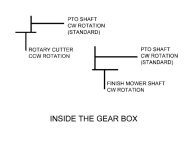Rowski
Veteran Member
- Joined
- May 18, 2000
- Messages
- 1,481
- Location
- North Central Vermont, Jay Peak Area
- Tractor
- 2004 New Holland TN70DA with 32LC loader, 2000 New Holland 2120 with Curtis cab, 7309 loader
Glenn
Would ground speed have anything to do with it? It would seem that slower ground speed would result in less windrowing, maybe? Also could the "tip" (front higher, lower or level with rear) of the cutter have something to do with it? Maybe the right combination of them all could fix or reduce the windrow problem.
Derek

Would ground speed have anything to do with it? It would seem that slower ground speed would result in less windrowing, maybe? Also could the "tip" (front higher, lower or level with rear) of the cutter have something to do with it? Maybe the right combination of them all could fix or reduce the windrow problem.
Derek


